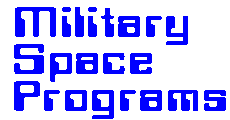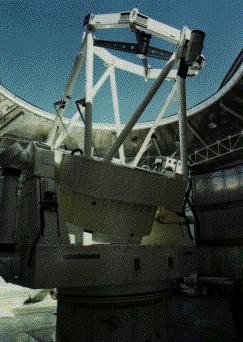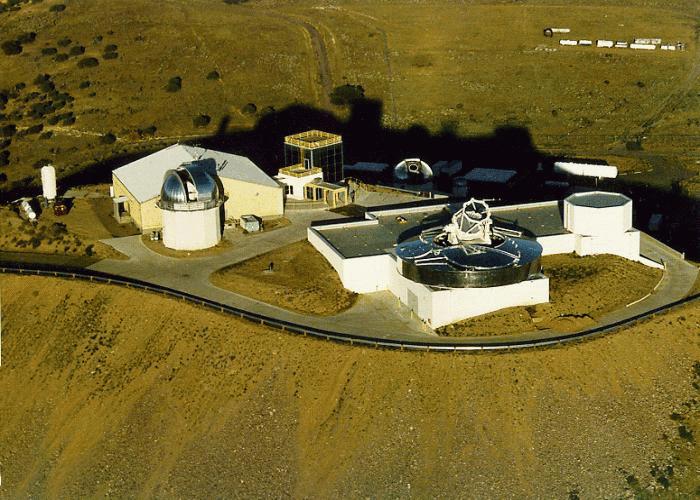



Starfire

The Air Force Phillips Laboratory at its Starfire optical Range (SOR) has
installed the world's largest telescope capable of tracking low earth-orbiting
satellites. The telescope has a 3.5-meter (1 l.5 feet) diameter primary mirror
and is protected by a unique retracting cylindrical enclosure that allows the
telescope to operate in the open air. once equipped with adaptive optics, the
telescope will be capable of resolving basketball-sized objects 1,OOO miles in
space.
The SOR is a world-class optical research facility located on a hilltop site
(6,24O feet above sea level) in the southeastern portion of Kirtland Air
Force Base, New Mexico. The SOR is the center for Air Force strategic optical
research. The primary mission of the SOR is to develop optical sensing,
imaging, and propagation technologies to support Air Force aerospace
missions.
This 3.5-meter telescope uses a spun cast borosilicate primary mirror
fabricated and polished by the University of Arizona's Steward observatory
Mirror Laboratory in Tucson. The lightweight honeycomb sandwich primary
mirror weighs 4,5OO pounds and has a one-inch thick glass facesheet. The
surface is polished to a precision of 21 nanometers, 3,OOO times thinner than
a human hair. The mirror is supported by 56 computer-controlled actuators to
maintain the surface figure while the telescope is moving. The mirror was
installed in August 1993, and first light images were achieved on February
10, 1994.
A unique feature of the 3.5-meter telescope is the protective enclosure
(or dome) consisting of three 9-foot high cylinders each 7O feet in diameter
that collapse around the telescope through a 35-foot diameter shuttered
opening in the roof. The enclosure is often likened to a collapsing Boy Scout
cup. This approach has two major advantages over conventional domes with
narrow slits: it does not have to be rotated at high speed for satellite
tracking, and it provides complete ventilation of the telescope to ambient
air which improves the quality of the images.
The effects of wind buffeting are minimized by the telescope's very stiff
structure and high-torque motors and by angular acceleration sensors which
control fast-steering mirrors designed to optically cancel out the image
jitter induced by the wind. Also, in severe conditions the enclosure can be
raised partially to shield the telescope. The enclosure was built by Coast
Steel in Vancouver, British Columbia, Canada.
The telescope, gimbal, optics, and support structures weigh more than 100
tons. The telescope sits on a massive steel-reinforced concrete pier weighing
more than 7OO tons which is isolated from the rest of the facility and
anchored in the bed rock with long steel rods. The telescope, gimbal,
structure, controls, secondary mirror, and auxiliary path optics were built
by Contraves USA in Pittsburgh, Pennsylvania. The facility and concrete
pier were built by Bradbury and Stamm of Albuquerque, New Mexico.
Thermal control of the telescope and facility is essential to maintain the
highest image quality. Another unique feature of the 3.5-meter facility is
the removal of heat by a closed cycle water system chilled by a large
"ice house" located 1/4 mile from the telescope. The concept is to make ice
in the daytime and store it in an underground pit for use at night.
This approach eliminates heat released into the air near the telescope
- as would be the case with conventional air-conditioning systems. The
3O-foot pit under the floor of the physical plant building has storage
capacity of 4.5 million pounds of ice. Propane fired boilers can generate
up to 2 million BTUs for hot water which is also supplied to the 3.5-
meter facility. Very precise temperature control of optical labs and
equipment can be achieved by mixing the right proportions of hot and
chilled water.
The Phillips Laboratory SOR research team is the leader in the development
of laser beacon adaptive optics for military applications and for civilian
applications such as astronomy. The objective over the next several years
is to develop and demonstrate laser beacon adaptive optics on the 3.5-meter
telescope. The knowledge gained with the l.5- meter telescope serves as a
foundation for advanced techniques which will be used on the 3.5-meter
telescope. The first tests with adaptive optics on the 3.5-meter telescope are
scheduled to occur in the spring of l995.

The total cost of the 3.5-meter telescope, enclosure, laboratories, physical
plant and all supporting facilities was $27 million. The research and
operations staff is comprised of approximately 50 military, civilian, and
contractor personnel. The staff includes physicists, mathematicians,
astronomers, electronic and mechanical engineers, optical designers and
technicians, sensor and computer specialists, laser technicians, a site
meteorologist, electricians, plumbers, welders, machinists, and a variety of
other specialists.
RESOURCES
http://www.fas.org/spp/military/program/track/starfire.htm
Maintained by Steven Aftergood
Created by John Pike
Updated December 31, 2003